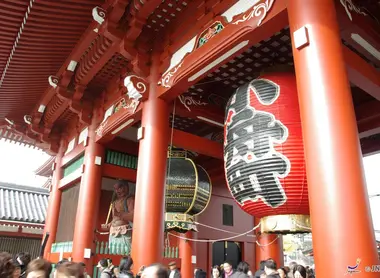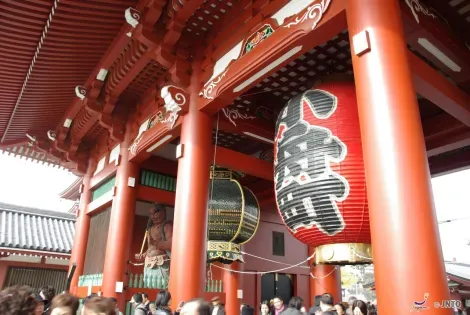Senso-ji temple in Asakusa 浅草寺
- Published on : 14/10/2019
- by : R.Z. / J.R.
- Youtube
Senso-ji, the oldest temple in Tokyo
Located in the Asakusa district of Tokyo, not far from the Sumida River, the Senso-ji Buddhist temple is particularly popular with the Japanese but also arouses the interest of tourists. Explore this imposing and unmissable Japanese cultural site.
Senso-ji and the goddess Kannon
The Senso-ji temple in Asakusa is dedicated to the Buddhist goddess Kannon.
Kannon, a bodhisattva (a being who has reached the state of enlightenment but who has chosen to suspend her status as a Buddha), is very popular in Japan because she embodies compassion. If at the base, Kannon (whose original name is Guanyin, Kannon being the Japanese version) is male, this bodhisattva is worshiped in its female form in Japan and China.
The temple is very popular with Tokyoites who attach great importance to Kannon. The Senso-ji in itself is imposing since it is erected in the center of a Buddhist complex whose enclosure encompasses the entire streets of the Asakusa district.
Senso-ji temple and its doors
The temple was founded in 645 after two brothers found a statuette of Kannon in the waters of the Sumida River.
The current Senso-ji is a reconstruction from 1958, the original having been destroyed during the American bombing raids of WWII on March 10, 1945. Everything was rebuilt identically, with more solid materials (the roof of the main building is today in titanium). In addition, major renovations took place in 2016 and 2017: today, the temple, its pagoda, and its two doors shine brightly, even at night. With its very traditional character and impressive size, Senso-ji is a Tokyo classic, popular with tourists and Japanese alike.
The entrance to the shrine is made up of an impressive portal, the Kaminarimon ("Thunder Gate"), from which hangs the largest red paper lantern in Japan, which weighs no less than 700 kg. This large gate, installed on the main avenue of the Asakusa district, marks the entrance to the sanctuary. The avenue is bustling with curious foreign and local visitors!
At the end of this alley, you will be able to see the monumental door which is the Hozomon ("Door of the treasure room"). It houses two large statues of Nio, traditional guardians of Japanese Buddhism, sporting a threatening face and responsible for preventing demons from entering the place. The Japanese have a habit of touching their oversized pilgrim sandals, the o-waraji, which are said to bring good luck and happiness.
The hondô (main building) can then be discovered, shining, and preceded by a large censer, the jokoro. The faithful have the habit of "bathing" in the smoke of incense, supposed to possess therapeutic power. To the left of the hondô stands the recently renovated 5-storey pagoda.
Kannon-do “of the goddess” is located at the main building of the temple, at the top of a flight of steps where visitors place an offering of coins or bills in the Saisen-bako “wooden coin box” followed by a traditional bow and the joining of the hands as a gesture of respect to Kannon. However, the statue of the goddess who gave her fame to the Senso-ji temple is not visible to the public and rests in the “treasure room’, reserved for the temple clerics.
Visit the Nakamise-dori
The visitors will discover an open-air shopping alley, often bustling with tourists, stretching for nearly 250 meters. This is the Nakamise-dori, where there are souvenir stands, traditional objects, and sweets to enjoy on the go. You will find just about everything there, in a happy swarm, shoulder to shoulder with curious visitors: Japanese fabrics, souvenirs, toys, chimes and lanterns, clothes, umbrellas, teapots ... but also street food and pastries that allow you to discover the heart of Japanese comfort food. Do not miss to taste a Ningyo-yaki, this typical Asakusa cake, filled with red bean paste and molded in various shapes resembling popular characters such as Hello Kitty, etc, and local attractions (especially in the shape of a pagoda!).
At the end of this alley, you will see the Hozomon (gates to the treasure room), impressive with its two statues of Nio, the guardian of the Buddha, and its two oversized pilgrim's sandals, the o-waraji, bringing luck and happiness to those who touch them.
Must-see around Senso-ji temple
The significance of Senso-ji is not only in the main hall but also in the five-story pagoda visible to the left of the temple, the second tallest pagoda in Japan behind Toji temple, south of Kyoto.
The unknown Asakusa-jinja temple to the right of the main hall is also the theater of the country's most famous Shinto festival, the Sanja Matsuri. Another marvel of Senso-ji, slightly out of the way, a haven of tranquility, the Japanese garden of the temple behind the pagoda offers an instant escape from the crowd as a school of Kois (Japanese Carp) gracefully swim across the garden pond.
The Senso-ji offers beautiful illumination after sundown offering a terrific photo opportunity and is open until 11 p.m. to the public.
Kannondo Hall 観音堂
The red and white Kannondo Hall is Sensoji Temple's main building, just past Hozonmon Gate. The Kannondo was first built in 1651, destroyed in World War II and rebuilt in 1958. The hall is said to hold a golden image of the Goddess of Mercy (kannon) discovered by three fishermen in the 7th century. This discovery is what gave birth to the temple. In front of the temple building is a large cauldron of incense, smoke from which is believed to bestow good health. Here people waft the incense smoke over themselves.
Goju-no-To Pagoda 五重塔
To the left is a five-story, 48 meter (157 ft) high Goju-no-To (five-story pagoda), rebuilt in 1973 and modeled after a similar structure at Daigoji Temple in Kyoto. Near the pagoda is Dembo-in - a picturesque tea garden built in the 17th century by noted landscape gardener, Enshu Kobori (1579-1647). Although the garden is closed to the public, it may be possible to arrange a viewing by calling in advance at the temple's main office.
Asakusa Shrine 浅草神社
To the right of the temple is the Asakusa Shrine, which miraculously escaped war-time bombs. The shrine was built on the orders of the third shogun Iemitsu in memory of the three fishermen and is the home shrine of the Sanja Matsuri held in May: Tokyo's biggest and loudest festival.
You can also climb to the top of the Tourist Office (located by the gate of Kaminarimon) to enjoy a birds-eye-view of Nakamise-dori and the renowned Tokyo Skytree.
- To read also: The Tôshô-gû shrine
Address, timetable & access
Address
Timetable
Asakusa station on the Ginza, Isesaki and Asakusa Toei linesPrice
Free admissionAccess
Open daily from 6 a.m. to 5 p.m. at 6 a.m., 10 a.m. and 2 p.m. religious ceremonies take place









































